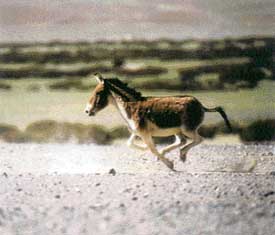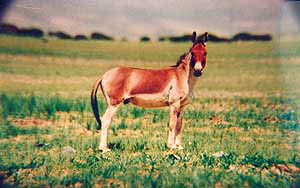My current exercise distraction is the full series of Planet Earth dvds. I bought a used set of the BBC version narrated by Richard Attenborough at a ridiculous price on eBay. As others have observed, there's lots of icky insectile stuff, lots of dominance competition and territory protecting, parched deserts, frozen tundra, and the like which can be off-putting when absorbed just before dinner, my usual time on the treadmill. But not off-putting enough to detract from the magnificent whole of this amazing adventure.
I recently viewed the program on grass plains which featured a segment on the Kiang, Tibet's wild asses. This you can view for yourself on Youtube (2 min, 35 sec):
One of the more unsettling segments is one about two large communities of chimpanzees which occupy neighboring territory. Quite recently I read a book about the behavior of human hunter-gathering societies. The chimps and humans behave with startlingly similar tactics: not just defending territory by warning off potential invaders -- as do many species -- but sending out warrior patrols for organized attacks within the territory controlled by a competing group.
The segment shows a chimp patrol moving silently up to the border and then stealthily into the territory of their neighbors. They initiate a surprise attack on the community, cooperate in killing one member of it, and then -- unpleasantly -- cannibalize him. Having done this they return home. It can't be known exactly what they achieve by this. They don't attempt to rule their neighbors as a conquered people and the attack is likely to fit into a complicated pattern by which they demonstrate their power, hone their ability to cooperate with each other, develop specialized roles for carrying out responsibilities, and keep up their hunting and fighting skills.
I couldn't find a Youtube of this segment, but there's one showing a wildlife cameraman discussing a similar attack by chimps on a group of monkeys (4 min). There are some shots from the same segment in this Discovery Channel video, but not ones of the patrol in action.
More on Kiang:





More on Chimps:
Chimp Warfare and Predators
Planet Earth part two - press pack

In the Ngogo forest in Uganda Planet Earth captures a natural history first when the largest chimpanzee group in the world – 150 strong – defends its territory from neighbouring chimp groups. On one patrol a youngster from a rival group is killed and eaten.




No comments:
Post a Comment